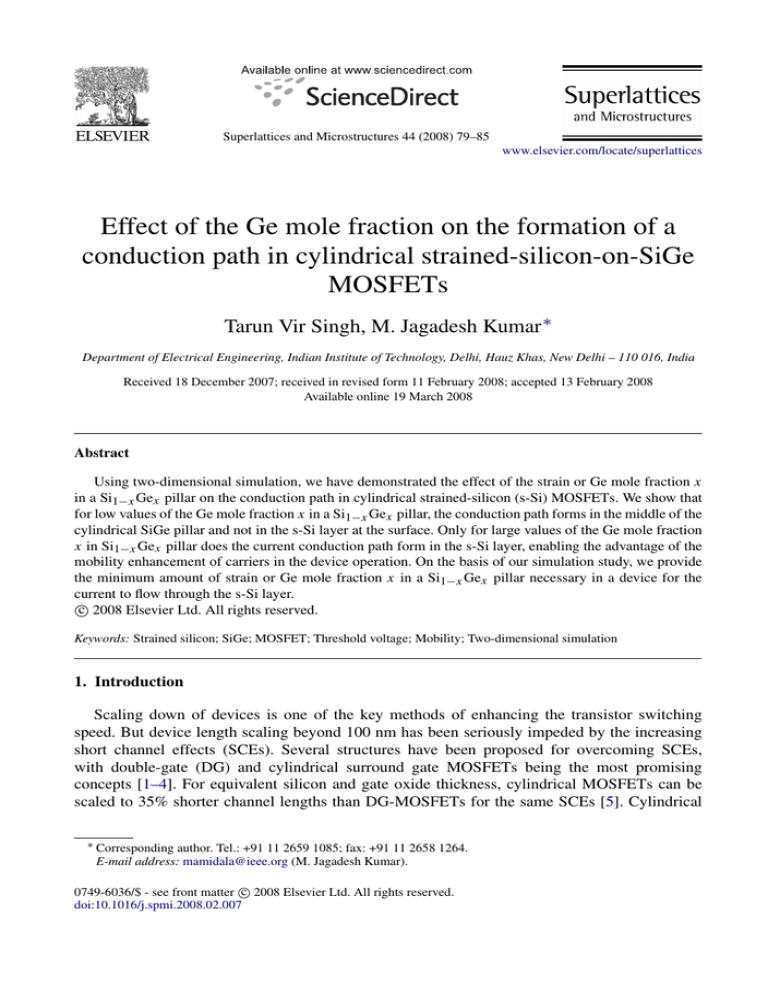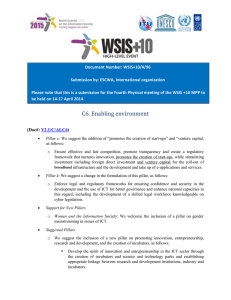
Superlattices and Microstructures 44 (2008) 79–85
www.elsevier.com/locate/superlattices
Effect of the Ge mole fraction on the formation of a
conduction path in cylindrical strained-silicon-on-SiGe
MOSFETs
Tarun Vir Singh, M. Jagadesh Kumar ∗
Department of Electrical Engineering, Indian Institute of Technology, Delhi, Hauz Khas, New Delhi – 110 016, India
Received 18 December 2007; received in revised form 11 February 2008; accepted 13 February 2008
Available online 19 March 2008
Abstract
Using two-dimensional simulation, we have demonstrated the effect of the strain or Ge mole fraction x
in a Si1−x Gex pillar on the conduction path in cylindrical strained-silicon (s-Si) MOSFETs. We show that
for low values of the Ge mole fraction x in a Si1−x Gex pillar, the conduction path forms in the middle of the
cylindrical SiGe pillar and not in the s-Si layer at the surface. Only for large values of the Ge mole fraction
x in Si1−x Gex pillar does the current conduction path form in the s-Si layer, enabling the advantage of the
mobility enhancement of carriers in the device operation. On the basis of our simulation study, we provide
the minimum amount of strain or Ge mole fraction x in a Si1−x Gex pillar necessary in a device for the
current to flow through the s-Si layer.
c 2008 Elsevier Ltd. All rights reserved.
Keywords: Strained silicon; SiGe; MOSFET; Threshold voltage; Mobility; Two-dimensional simulation
1. Introduction
Scaling down of devices is one of the key methods of enhancing the transistor switching
speed. But device length scaling beyond 100 nm has been seriously impeded by the increasing
short channel effects (SCEs). Several structures have been proposed for overcoming SCEs,
with double-gate (DG) and cylindrical surround gate MOSFETs being the most promising
concepts [1–4]. For equivalent silicon and gate oxide thickness, cylindrical MOSFETs can be
scaled to 35% shorter channel lengths than DG-MOSFETs for the same SCEs [5]. Cylindrical
∗ Corresponding author. Tel.: +91 11 2659 1085; fax: +91 11 2658 1264.
E-mail address: mamidala@ieee.org (M. Jagadesh Kumar).
c 2008 Elsevier Ltd. All rights reserved.
0749-6036/$ - see front matter doi:10.1016/j.spmi.2008.02.007
80
T.V. Singh, M. Jagadesh Kumar / Superlattices and Microstructures 44 (2008) 79–85
MOSFETs offer additional advantages of improved subthreshold slope, higher packing densities,
variable pillar doping (along the channel).
The second main factor controlling transistor switching speed is the carrier velocity (or
mobility). Strained Si has been used in recent years to improve carrier transport properties,
i.e. mobility and high field velocity, and a number of studies have shown the usefulness of
strained silicon in extremely scaled down MOSFETs [6–10].
To incorporate the advantages of both the cylindrical surround gate and the strained silicon,
strained-Si surround gate MOSFETs have recently been proposed [11]. This device consists of a
SiGe pillar over which silicon is grown so that it becomes strained. The amount of strain created
in the silicon layer depends on the Ge mole fraction in the SiGe pillar. In the conventional singlegate or double-gate s-Si MOSFETs, the inversion layer forms (and therefore current flows) near
the s-Si/SiO2 interface of the device. Due to the mobility enhancement in the s-Si layer, these
transistors exhibit enhanced drain current. However, we show in this paper that in the case of
cylindrical strained-Si-on-SiGe MOSFETs, the inversion layer forms in the center of the SiGe
pillar if the Ge mole fraction x in Si1−x Gex pillar is not chosen appropriately. To derive the
mobility enhancement, the conduction path or the inversion layer must be formed in the strainedsilicon layer. Using two-dimensional simulation, we estimate the minimum amount of strain or
Ge mole fraction x in the Si1−x Gex pillar necessary for the conduction path to be formed in the
s-Si layer. We show that the minimum Ge mole fraction x in a Si1−x Gex pillar required increases
as the pillar diameter increases but is independent of the s-Si layer thickness. An increase in
strain or Ge mole fraction x in a Si1−x Gex pillar leads to a fall in the threshold voltage of the
device [12]. Hence, strain can be introduced effectively in thick-pillar devices only if threshold
voltage roll-off can be tolerated.
The simulation work presented in this work is primarily aimed at providing guidelines and
motivation for the experimental implementation of cylindrical s-Si-on-SiGe MOSFETs. This
study provides the preliminary possibilities and limitations of these devices in order to allow
making an appropriate selection of Ge mole fraction x in a Si1−x Gex pillar.
2. Strain related models used in 2D simulation
A silicon thin film grown pseudomorphically over a relaxed Si1−x Gex substrate experiences
biaxial strain leading to changes in band structure [9,13]. Due to strain, the electron affinity of
silicon increases and the bandgap decreases. The effect of strain on Si band structure can be
modeled as [9,13,14]
(1E C )s-Si = 0.57x
(1E g )s-Si = 0.4x
!3/2
m ∗h,Si
N V,Si
φt ln
= φt ln
≈ 0.075x
N V,s-Si
m ∗h,s-Si
(1)
(2)
where x is the Ge mole fraction in the Si1−x Gex substrate, (1E c )s-Si is the decrease in electron
affinity of silicon due to strain, (1E g )s-Si is the decrease in bandgap of silicon due to strain, φt is
the thermal voltage, N V,Si and N V,s-Si are the densities of states in the valence bands in normal
and strained silicon respectively. The energy band parameters for Si1−x Gex substrate can also be
estimated as [9,13,14]
N V,SiGe = (0.6x + 1.04(1 − x)) × 1019 cm−3 ,
(1E g )SiGe = 0.467x,
εSiGe = 11.8 + 4.2x
(3)
81
T.V. Singh, M. Jagadesh Kumar / Superlattices and Microstructures 44 (2008) 79–85
Fig. 1. Cross-sectional view of the strained-Si vertical surrounding gate MOSFET.
Table 1
Device parameters used in the simulation
Parameter
Value
Channel length, L
SiGe pillar radius (R1 )
Strained-silicon film thickness, ts-Si
Source/drain doping, N D
Doping in SiGe layers, N A
Doping in s-Si layer, N A
Drain bias, V DS
Gate oxide thickness, tox
Work function of gate material, φ M
100 nm
30–80 nm
5–20 nm
1019 cm−3
1016 cm−3
1016 cm−3
0.05 V (50 mV)
2.0 nm
4.8 eV
where (1E g )SiGe is the decrease in bandgap of Si1−x Gex from that of Si, N V,SiGe is the density
of states in the valence band in relaxed Si1−x Gex , and εSiGe is the permittivity of Si1−x Gex .
A schematic view of a fully depleted cylindrical surround gate strained MOSFET simulated
using 2D device simulator ATLAS [15] is shown in Fig. 1, in which the above strain related
models are implemented. The parameters used in our simulation are given in Table 1. In this study
we have considered a channel length of 100 nm. However, when the channel length is far less than
100 nm, to incorporate the quantum-mechanical effects, one can use the self-consistent coupled
Schrödinger–Poisson model in ATLAS in which the Schrödinger and Poisson’s equations are
solved alternately.
The associated energy band diagram from the center of the pillar to its surface is shown in
Fig. 2 for different values of the Ge mole fraction x in the Si1−x Gex substrate. With increasing
strain (due to increased Ge mole fraction x), the larger electron affinity leads to electron injection
from the SiGe pillar into the s-Si layer and the lower bandgap leads to larger pumping of electrons
from the valence band to the conduction band. Hence, the inversion layer electron concentration
will be more in the s-Si layer as strain is increased.
Fig. 3 depicts the electron concentration across the device from the center of the pillar to
its surface for different values of strain (i.e. different values of the Ge mole fraction x in the
82
T.V. Singh, M. Jagadesh Kumar / Superlattices and Microstructures 44 (2008) 79–85
Fig. 2. Energy band diagram of the structure in Fig. 1 (in the radial direction, from the center of the pillar to the surface)
for different values of strain x (Ge content in the SiGe film).
Fig. 3. Electron concentration profile in the radial direction (from the center of the pillar to the surface).
Si1−x Gex pillar). For low values of strain (i.e. lower Ge mole fraction x in the Si1−x Gex pillar),
the inversion layer electron concentration is negligible in the s-Si layer compared to its value
in the center of the SiGe pillar. Therefore, the majority of the current flow is expected to
flow through the SiGe pillar; whereas for high values of strain (i.e. greater Ge mole fraction
x in the Si1−x Gex pillar), the current flow should shift to the s-Si layer due to its significantly
large inversion layer concentration. This is the preferred mode of current conduction due to the
mobility enhancement in the strained-silicon layer.
T.V. Singh, M. Jagadesh Kumar / Superlattices and Microstructures 44 (2008) 79–85
83
Fig. 4. Electron concentration profile in the radial direction at the threshold point.
3. Minimum required Ge mole fraction for threshold condition
Using a 2D device simulator, we have estimated the minimum amount of Ge mole fraction x
in a Si1−x Gex pillar required to make the inversion layer charge concentration larger in the s-Si
layer than in the SiGe pillar so that a significant inversion layer forms in the s-Si layer and not
in the SiGe pillar. We have defined the minimum required Ge mole fraction x in the Si1−x Gex
pillar as the condition where the electron concentration in the center of the SiGe pillar is 10 times
smaller than the background doping when the peak electron concentration in the s-Si layer equals
the background doping. In other words, the gate voltage at which the peak electron concentration
in the SiGe pillar is 10 times smaller than the peak electron concentration in the s-Si layer is
taken as the threshold condition. This is depicted in Fig. 4.
4. Results and discussion
Fig. 5 shows the variation of the minimum required strain Ge mole fraction x in a Si1−x Gex
pillar with the SiGe pillar radius. It is observed that the amount of strain and hence the Ge mole
fraction x in the Si1−x Gex pillar necessary to form the conduction path in the s-Si layer increases
as the pillar radius increases. This happens because for larger radii, many more electrons must
be transferred from the thick pillar to the s-Si layer. Thus, thick cylindrical s-Si MOSFETs must
employ a large amount of Ge mole fraction x in a Si1−x Gex pillar. Fig. 5 also shows the variation
of the threshold voltage of the device with the SiGe pillar radius. The threshold voltage has been
obtained for the amount of Ge mole fraction x in the Si1−x Gex pillar equal to the minimum
required strain in the device. We observe that in order to effectively introduce strain in thickpillar devices, threshold voltage roll-off must be tolerated. This is because thick-pillar devices
need a large amount of strain and an increase in Ge mole fraction x in a Si1−x Gex pillar leads to
a fall in the threshold voltage.
Fig. 6 shows the variation of the minimum required Ge mole fraction x in a Si1−x Gex pillar
with s-Si film thickness, ts-Si , for different values of SiGe pillar radius. It is observed that
minimum required strain or Ge mole fraction x in a Si1−x Gex pillar is essentially independent of
ts-Si for the range from 5 nm to 20 nm.
84
T.V. Singh, M. Jagadesh Kumar / Superlattices and Microstructures 44 (2008) 79–85
Fig. 5. Variation of minimum required strain or Ge mole fraction x in a Si1−x Gex pillar with the SiGe pillar radius.
Fig. 6. Variation of minimum required strain or Ge mole fraction x in a Si1−x Gex pillar with strained-Si film thickness
ts-Si .
5. Conclusions
In this paper, we have examined the effect of the Ge mole fraction x in a Si1−x Gex pillar on the
formation of the conduction path in cylindrical strained-silicon MOSFETs using 2D simulation.
We have shown that in order for the conduction path to be formed in the s-Si layer, the amount
of strain or the Ge mole fraction x in a Si1−x Gex pillar in cylindrical s-Si MOSFETs must be
T.V. Singh, M. Jagadesh Kumar / Superlattices and Microstructures 44 (2008) 79–85
85
above a certain minimum value. Only then will the current conduction path form in the s-Si layer,
enabling the mobility enhancement to be used for enhanced drain current. Further, for thick-pillar
devices, the minimum required strain or Ge mole fraction x in a Si1−x Gex pillar is quite high,
which leads to threshold voltage roll-off.
References
[1] S. Locci, M. Maccioni, E. Orgiu, A. Bonfiglio, An analytical model for cylindrical thin-film transistors, IEEE Trans.
Electron Devices 54 (2007) 2362–2368.
[2] J. He, Y.D. Tao, F. Liu, J. Feng, S.Q. Yang, Analytic channel potential solution to the undoped surrounding-gate
MOSFETs, Solid-state Electron. 51 (2007) 802–805.
[3] G.V. Reddy, M.J. Kumar, A new dual-material double-gate (DMDG) nanoscale SOI MOSFET — two-dimensional
analytical modeling and simulation, IEEE Trans. Nanotechnol. 4 (2005) 260–268.
[4] H. Jeong, K.W. Song, I.H. Park, T.H. Kim, Y.S. Lee, S.G. Kim, J. Seo, K. Cho, K. Lee, H. Shin, J.D. Lee, B.G.
Park, A new capacitorless 1T DRAM cell: Surrounding gate MOSFET with vertical channel (SGVC cell), IEEE
Trans. Nanotechnol. 6 (2007) 352–357.
[5] S.-H. Oh, D. Monroe, J.M. Hergenrother, Analytic description of short-channel effects in fully-depleted double-gate
and cylindrical, surrounding-gate MOSFETs, IEEE Electron Device Lett. 21 (2000) 445–447.
[6] G. Hadjisavvas, L. Tsetseris, S.I. Pantelides, The origin of electron mobility enhancement in strained MOSFETs,
IEEE Electron Device Lett. 28 (2007) 1018–1020.
[7] T. Benshidoum, G. Ghibaudo, F. Boeuf, Comparison of carrier velocity gain in uniaxially and biaxially strained
N-MOSFETs, Electron. Lett. 43 (2007) 647–649.
[8] T. Krishnamohan, C. Jungemann, D. Kim, E. Ungersboeck, S. Selberherr, A.T. Pham, B. Meinerzhagen, P. Wong,
Y. Nishi, K.C. Saraswat, High performance, uniaxially-strained, silicon and germanium, double-gate p-MOSFETs,
Microelectron. Eng. 84 (2007) 2063–2066.
[9] F. Andrieu, O. Weber, T. Ernst, O. Faynot, S. Deleonibus, Strain and channel engineering for fully depleted SOI
MOSFETs towards the 32 nm technology node, Microelectron. Eng. 84 (2007) 2047–2053.
[10] V. Aubry-Fortuna, A. Bournel, P. Dollfus, S. Galdin-Retailleau, Ultra-short n-MOSFETs with strained Si: device
performance and the effect of ballistic transport using Monte Carlo simulation, Semicond. Sci. Technol. 21 (2006)
422–428.
[11] Y. Li, J.W. Lee, H.M. Chou, Silicon–germanium structure in surrounding-gate strained silicon nanowire field effect
transistors, J. Comput. Electron. 3 (2004) 251–255.
[12] M.J. Kumar, V. Venkataraman, S. Nawal, Impact of strain or Ge content on the threshold voltage of nanoscale
strained-Si/SiGe bulk MOSFETs, IEEE Trans. Device Mater. Reliab. 7 (2007) 181–187.
[13] W. Zhang, J.G. Fossum, On the threshold voltage of strained-Si–Si1−x Gex MOSFETs, IEEE Trans. Electron
Devices 52 (2005) 263–268.
[14] T. Numata, T. Mizuno, T. Tezuka, J. Koga, S. Takagi, Control of threshold-voltage and short-channel effects in
ultrathin strained-SOI CMOS Devices, IEEE Trans. Electron Devices 52 (2005) 1780–1786.
[15] ATLAS, Silvaco International, Santa Clara, CA.



